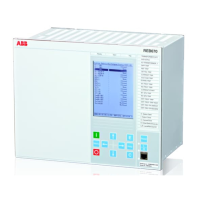• Voltage (3V
0
or V
2
)
• Curr
ent (3I
0
· ZNpol or 3I
2
·ZNpol where ZNpol is RNpol + jXNpol), or
• both currents and voltage, Dual (dual polarizing, (3V
0
+ 3I
0
· ZNpol) or (V
2
+ I
2
·
ZNpol)).
Normally voltage polarizing from the internally calculated residual sum or an external
open delta is used.
Current polarizing is useful when the local source is strong and a high sensitivity is
required. In such cases the polarizing voltage (3V
0
) can be below 1% and it is then
necessary to use current polarizing or dual polarizing. Multiply the required set current
(primary) with the minimum impedance (ZNpol) and check that the percentage of the
phase-to-ground voltage is definitely higher than 1% (minimum 3V
0
>VPolMin setting)
as a verification.
RNPol, XNPol: The zero-sequence source is set in primary ohms as base for the current
polarizing. The polarizing voltage is then achieved as 3I
0
· ZNpol. The ZNpol can be
defined as (ZS
1
-ZS
0
)/3, that is the ground return impedance of the source behind the
protection. The maximum ground-fault current at the local source can be used to
calculate the value of ZN as V/(√3 · 3I
0
) Typically, the minimum ZNPol (3 · zero
sequence source) is set. The setting is in primary ohms.
When the dual polarizing method is used, it is important that the setting Pickupx or the
product 3I
0
· ZNpol is not greater than 3V
0
. If so, there is a risk for incorrect operation
for faults in the reverse direction.
IPolMin: is the minimum ground-fault current accepted for directional evaluation. For
smaller currents than this value, the operation will be blocked. A typical setting is
5-10% of IB.
VPolMin: Minimum polarization (reference) polarizing voltage for the directional
function, given in % of VBase/√3.
IDirPU: Operate residual current release level in % of IB for directional comparison
scheme. The setting is given in % of IB and must be set below the lowest INx> setting,
set for the directional measurement. The output signals, PUFW and PUREV can be
used in a teleprotection scheme. The appropriate signal should be configured to the
communication scheme block.
7.3.2.2 2nd harmonic restrain
M15282-90 v6
If a power transformer is energized there is a risk that the current transformer core will
saturate during part of the period, resulting in a transformer inrush current. This will
give a declining residual current in the network, as the inrush current is deviating
1MRK 505 370-UUS A Section 7
Current protection
Busbar protection REB670 2.2 ANSI 199
Application manual

